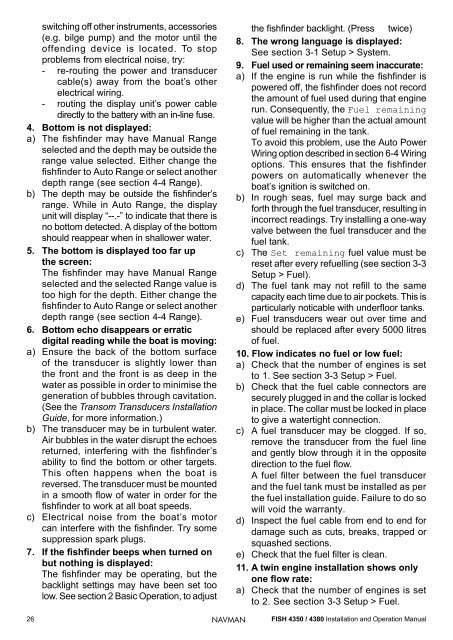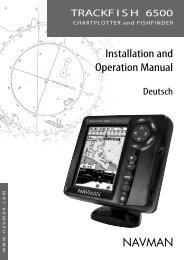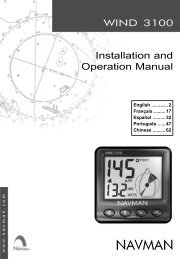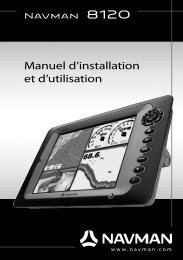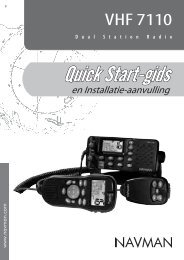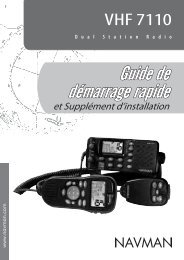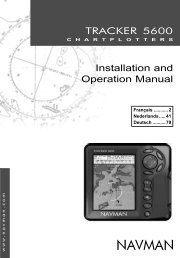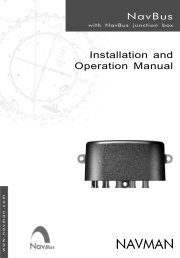English - Navman Marine
English - Navman Marine
English - Navman Marine
Create successful ePaper yourself
Turn your PDF publications into a flip-book with our unique Google optimized e-Paper software.
switching off other instruments, accessories<br />
(e.g. bilge pump) and the motor until the<br />
offending device is located. To stop<br />
problems from electrical noise, try:<br />
- re-routing the power and transducer<br />
cable(s) away from the boat’s other<br />
electrical wiring.<br />
- routing the display unit’s power cable<br />
directly to the battery with an in-line fuse.<br />
4. Bottom is not displayed:<br />
a) The Þ shÞ nder may have Manual Range<br />
selected and the depth may be outside the<br />
range value selected. Either change the<br />
Þ shÞ nder to Auto Range or select another<br />
depth range (see section 4-4 Range).<br />
b) The depth may be outside the ÞshÞnder’s<br />
range. While in Auto Range, the display<br />
unit will display “--.-” to indicate that there is<br />
no bottom detected. A display of the bottom<br />
should reappear when in shallower water.<br />
5. The bottom is displayed too far up<br />
the screen:<br />
The Þ shÞ nder may have Manual Range<br />
selected and the selected Range value is<br />
too high for the depth. Either change the<br />
Þ shÞ nder to Auto Range or select another<br />
depth range (see section 4-4 Range).<br />
6. Bottom echo disappears or erratic<br />
digital reading while the boat is moving:<br />
a) Ensure the back of the bottom surface<br />
of the transducer is slightly lower than<br />
the front and the front is as deep in the<br />
water as possible in order to minimise the<br />
generation of bubbles through cavitation.<br />
(See the Transom Transducers Installation<br />
Guide, for more information.)<br />
b) The transducer may be in turbulent water.<br />
Air bubbles in the water disrupt the echoes<br />
returned, interfering with the Þ shÞ nder’s<br />
ability to Þ nd the bottom or other targets.<br />
This often happens when the boat is<br />
reversed. The transducer must be mounted<br />
in a smooth ß ow of water in order for the<br />
Þ shÞ nder to work at all boat speeds.<br />
c) Electrical noise from the boat’s motor<br />
can interfere with the Þ shÞ nder. Try some<br />
suppression spark plugs.<br />
7. If the ÞshÞnder beeps when turned on<br />
but nothing is displayed:<br />
The Þ shÞ nder may be operating, but the<br />
backlight settings may have been set too<br />
low. See section 2 Basic Operation, to adjust<br />
the ÞshÞnder backlight. (Press twice)<br />
8. The wrong language is displayed:<br />
See section 3-1 Setup > System.<br />
9. Fuel used or remaining seem inaccurate:<br />
a) If the engine is run while the Þ shÞ nder is<br />
powered off, the Þ shÞ nder does not record<br />
the amount of fuel used during that engine<br />
run. Consequently, the Fuel remaining<br />
value will be higher than the actual amount<br />
of fuel remaining in the tank.<br />
To avoid this problem, use the Auto Power<br />
Wiring option described in section 6-4 Wiring<br />
options. This ensures that the fishfinder<br />
powers on automatically whenever the<br />
boat’s ignition is switched on.<br />
b) In rough seas, fuel may surge back and<br />
forth through the fuel transducer, resulting in<br />
incorrect readings. Try installing a one-way<br />
valve between the fuel transducer and the<br />
fuel tank.<br />
c) The Set remaining fuel value must be<br />
reset after every refuelling (see section 3-3<br />
Setup > Fuel).<br />
d) The fuel tank may not reÞ ll to the same<br />
capacity each time due to air pockets. This is<br />
particularly noticable with underßoor tanks.<br />
e) Fuel transducers wear out over time and<br />
should be replaced after every 5000 litres<br />
of fuel.<br />
10. Flow indicates no fuel or low fuel:<br />
a) Check that the number of engines is set<br />
to 1. See section 3-3 Setup > Fuel.<br />
b) Check that the fuel cable connectors are<br />
securely plugged in and the collar is locked<br />
in place. The collar must be locked in place<br />
to give a watertight connection.<br />
c) A fuel transducer may be clogged. If so,<br />
remove the transducer from the fuel line<br />
and gently blow through it in the opposite<br />
direction to the fuel ß ow.<br />
A fuel Þ lter between the fuel transducer<br />
and the fuel tank must be installed as per<br />
the fuel installation guide. Failure to do so<br />
will void the warranty.<br />
d) Inspect the fuel cable from end to end for<br />
damage such as cuts, breaks, trapped or<br />
squashed sections.<br />
e) Check that the fuel Þ lter is clean.<br />
11. A twin engine installation shows only<br />
one ßow rate:<br />
a) Check that the number of engines is set<br />
to 2. See section 3-3 Setup > Fuel.<br />
26 NAVMAN<br />
FISH 4350 / 4380 Installation and Operation Manual


